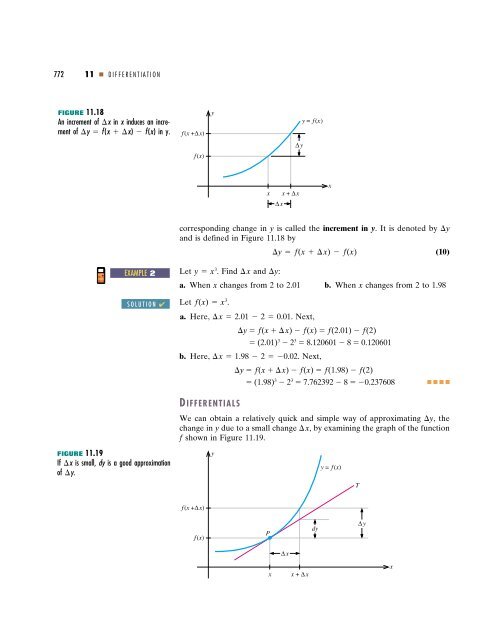11DIFFERENTIATION - Department of Mathematics
11DIFFERENTIATION - Department of Mathematics
11DIFFERENTIATION - Department of Mathematics
Create successful ePaper yourself
Turn your PDF publications into a flip-book with our unique Google optimized e-Paper software.
772 11 DIFFERENTIATION<br />
FIGURE 11.18<br />
An increment <strong>of</strong> x in x induces an increment<br />
<strong>of</strong> y f(x x) f(x) iny.<br />
EXAMPLE 2<br />
SOLUTION ✔<br />
FIGURE 11.19<br />
If x is small, dy is a good approximation<br />
<strong>of</strong> y.<br />
f(x +∆x)<br />
f(x)<br />
y<br />
x x + ∆x<br />
∆ x<br />
∆ y<br />
y = f(x)<br />
corresponding change in y is called the increment in y. It is denoted by y<br />
and is defined in Figure 11.18 by<br />
y f(x x) f(x) (10)<br />
Let y x3 . Find x and y:<br />
a. When x changes from 2 to 2.01 b. When x changes from 2 to 1.98<br />
Let f(x) x3 .<br />
a. Here, x 2.01 2 0.01. Next,<br />
y f(x x) f(x) f(2.01) f(2)<br />
(2.01) 3 23 8.120601 8 0.120601<br />
b. Here, x 1.98 2 0.02. Next,<br />
y f(x x) f(x) f(1.98) f(2)<br />
(1.98) 3 23 7.762392 8 0.237608 <br />
D IFFERENTIALS<br />
We can obtain a relatively quick and simple way <strong>of</strong> approximating y, the<br />
change in y due to a small change x, by examining the graph <strong>of</strong> the function<br />
f shown in Figure 11.19.<br />
f (x +∆x)<br />
f(x)<br />
y<br />
P<br />
∆ x<br />
x x + ∆x<br />
dy<br />
x<br />
y = f (x)<br />
T<br />
∆ y<br />
x

















